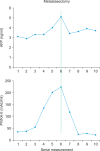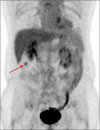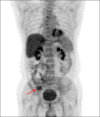Management of very late peritoneal metastasis of hepatocellular carcinoma 10 years after liver transplantation: Lessons from two cases
- PMID: 29896574
- PMCID: PMC5981143
- DOI: 10.14701/ahbps.2018.22.2.136
Management of very late peritoneal metastasis of hepatocellular carcinoma 10 years after liver transplantation: Lessons from two cases
Abstract
Recurrence of hepatocellular carcinoma (HCC) 10 years after liver transplantation (LT) is very rare. Here, we present two cases of peritoneal metastasis of HCC that occurred 10 and 12 years after LT. A 77-year-old male who had undergone deceased-donor LT 10 years earlier showed slow progressive elevation of tumor marker levels over 6 months. Close observation with frequent imaging studies and monthly tumor marker analyses revealed a solitary peritoneal seeding mass. Imaging studies revealed that the mass was highly likely to be metastatic HCC. After excision of the mass, all tumor markers returned to the normal range. Over past 10 months, the patient has received everolimus monotherapy and half-dose sorafenib, and has shown no evidence of HCC recurrence. In the second case, marginally elevated tumor marker levels were detected in a 65-year-old male who had undergone living-donor LT 12 years earlier. After observation for 3 months, follow-up studies revealed a peritoneal seeding mass. Thorough imaging studies revealed that the mass was highly likely to be metastatic HCC. Two mass lesions were excised, and the patient was administered low-dose calcineruin inhibitor, sirolimus, and full-dose sorafenib. Subsequently, the tumor marker levels increased again and growth of new peritoneal seeding nodules was observed; therefore, sorafenib was stopped after 2 years of administration. During 6 years since HCC recurrence diagnosis, the patient has experienced slowly growing tumors, but has been doing well. For very late peritoneal metastasis of HCC, the therapeutic modalities include surgical resection if possible, everolimus monotherapy, and long-term use of sorafenib.
Keywords: Hepatocellular carcinoma; Metastasis; Recurrence; Resection; Sorafenib.
Figures









Similar articles
-
Successful Total En Bloc Spondylectomy of T7 Vertebra for Hepatocellular Carcinoma Metastasis After Living Donor Liver Transplantation.Spine (Phila Pa 1976). 2015 Aug 15;40(16):E944-7. doi: 10.1097/BRS.0000000000000930. Spine (Phila Pa 1976). 2015. PMID: 25893346
-
Efficacy and safety of combination therapy with everolimus and sorafenib for recurrence of hepatocellular carcinoma after liver transplantation.Transplant Proc. 2014 Jan-Feb;46(1):241-4. doi: 10.1016/j.transproceed.2013.10.035. Transplant Proc. 2014. PMID: 24507059
-
Sorafenib delays recurrence and metastasis after liver transplantation in a rat model of hepatocellular carcinoma with high expression of phosphorylated extracellular signal-regulated kinase.Liver Transpl. 2013 May;19(5):507-20. doi: 10.1002/lt.23619. Liver Transpl. 2013. PMID: 23408515
-
Hepatocellular Carcinoma and Liver Transplantation: State of the Art.J Clin Transl Hepatol. 2014 Sep;2(3):176-81. doi: 10.14218/JCTH.2014.00013. Epub 2014 Sep 15. J Clin Transl Hepatol. 2014. PMID: 26357625 Free PMC article. Review.
-
Recurrent Hepatocellular Carcinoma in the Right Adrenal Gland 11 Years After Liver Transplantation for Hepatocellular Carcinoma: a Case Report and Literature Review.Indian J Surg. 2017 Oct;79(5):450-454. doi: 10.1007/s12262-017-1680-5. Epub 2017 Aug 17. Indian J Surg. 2017. PMID: 29089708 Free PMC article. Review.
Cited by
-
Cross-sectional analysis of immunosuppressive regimens focused on everolimus after liver transplantation in a Korean high-volume transplantation center.Korean J Transplant. 2019 Dec 31;33(4):98-105. doi: 10.4285/jkstn.2019.33.4.98. Korean J Transplant. 2019. PMID: 35769980 Free PMC article.
-
Clinical Features and Surveillance of Very Late Hepatocellular Carcinoma Recurrence After Liver Transplantation.Ann Transplant. 2018 Sep 21;23:659-665. doi: 10.12659/AOT.910598. Ann Transplant. 2018. PMID: 30237389 Free PMC article.
-
Commentary: Case Report: Lenvatinib for the treatment of recurrent hepatocellular carcinoma in people living with HIV: a report of two cases.Front Oncol. 2024 Apr 5;14:1372745. doi: 10.3389/fonc.2024.1372745. eCollection 2024. Front Oncol. 2024. PMID: 38646433 Free PMC article. No abstract available.
References
-
- Lee SG, Hwang S, Moon DB, Ahn CS, Kim KH, Sung KB, et al. Expanded indication criteria of living donor liver transplantation for hepatocellular carcinoma at one large-volume center. Liver Transpl. 2008;14:935–945. - PubMed
-
- Mazzaferro V, Regalia E, Doci R, Andreola S, Pulvirenti A, Bozzetti F, et al. Liver transplantation for the treatment of small hepatocellular carcinomas in patients with cirrhosis. N Engl J Med. 1996;334:693–699. - PubMed
-
- Hwang S, Lee SG, Joh JW, Suh KS, Kim DG. Liver transplantation for adult patients with hepatocellular carcinoma in Korea: comparison between cadaveric donor and living donor liver transplantations. Liver Transpl. 2005;11:1265–1272. - PubMed
-
- Yao FY, Ferrell L, Bass NM, Watson JJ, Bacchetti P, Venook A, et al. Liver transplantation for hepatocellular carcinoma: expansion of the tumor size limits does not adversely impact survival. Hepatology. 2001;33:1394–1403. - PubMed
Publication types
LinkOut - more resources
Full Text Sources
Other Literature Sources
Miscellaneous
